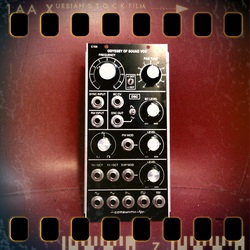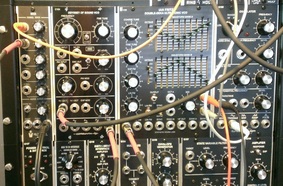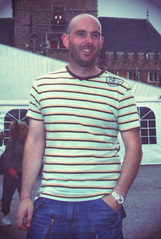
One thing that you notice straight away is how shiny the finish is. Unlike the other modules in my rack it is very dark black and very reflective. I think the finish is lovely and it does not aggravate my OCD. It fits in well with it's new neighbors in the Atomic Synthesis System.
The module is solid and the finish is flawless. Top quality knobs, jacks and switches are used throughout. One does notice some superficial similarity to the Synthesizers DotCom Q106 module. However the C104 has some nice extras that it brings to the party.

All of the traditional analog waveforms are available simultaneously from the bottom row of jacks. Oscillator synch and pulse width modulation are present and accounted for. Pulse width is preset at 10% to 90%.
There is also a built in ring modulator and a diode soft clipping circuit.

A quick look at his website shows that he has a low pass filter that is based on the Roland SH-1/SH-101/JP-8 design, as well as voltage controlled LFO and frequency divider/multiplier modules. He has high rez photos, PDF manuals and ample SoundCloud tracks of all of his modules on the various product pages.
I have found him to be very prompt with answers to questions. Here are some of the questions that were posedposed for this article and his answers.
At this moment I own :
-MU format modular synth mix of Corsynth, Synthesizers.com and DIY modules
-MFOS Sound Lab Ultimate + Expander
-MFOS Sequencer
-Ensoniq ESQ-1
-Moog Realistic MG-1
But to tell the truth I spend most of my time with the modular synth. I really have fun patching and creating new sounds.
Why synth modules?
Before I started Corsynth I was a modular user and DIY enthusiastic so to start designing my own modules was a natural evolution. I like the fact that adding a module to a system can open a new world of possibilities. Many times adding a new module is like having a new synth.
Your design philosophy?
As I said before I'm a modular user so every time I start to think about a new module is because I feel that I need that module in my system. For example when I designed the C102 VC-LFO I was missing a dedicated VC LFO in my system and also there wasn't many options in MU format so I decided to design it.
What new products do you have in the works?
In October I'm going to release the Corsynth C105 that will be a sound generator and an audio processor. My idea for the future to offer enough variety of modules so you could create a complete modular system using only Corsynth modules. So there will be Corsynth VCAs, envelopes , mixers.....
The C104 is similar in layout to the DotCom Q106. How are they different?
The C104 and the Q106 can look similar but they have many different features. The main differences are that the C104 includes a CMOS Ring Modulator and a Diode soft Clipping and the Q106 have Linear FM. Other important difference is that the C104 has limited Pulse Width and it can be over-modulated. This means that you will not loose the audio signal because the pulse width will be always between 10% and 90%. Despite the fact that the C104 can go into the sub audio range (more or less 2Hz) it's not designed to be a LFO as the Q106. The last important difference is that the C104 has Coarse Frequency and Fine Frequency controls along with a +/-1 Octave switch, the Q106 has a frequency range selector and a Fine Frequency control. I really like the Coarse Frequency control in the VCOs because allow you to have a wider frequency range available from the front panel and I was missing this feature in my Q106s, maybe because I like to experiment with the modular more than create "normal music".
Most of the other large format modules are finished in a semi-gloss finish. Your's are a very glossy black. Was that a deliberate decision or was it based on some other consideration?
The first modules ( C101 , C102 and C103 ) also had a semi-gloss finish. After the C103 I've changed my front panel supplier. When I contacted with them for the first time they send me a sample of how the panel would look like and I really liked it, that's the story :)
Do you have a degree in electronics or are you self taught?
I had taken a few courses of electronics at the university but I got really interested in electronics when I discovered the SDIY community. Since that moment I started to read everything that I could find about synth design, I bought a copy of Electronotes, old electronics books.... I became some kind of synth design junkie.
Do you ever feel that the more experimental modules are happening in EuroRack and that the large format is too bound up with traditional synthesis modules? Have you ever thought of making some more Buchla type features in large format modules?
I think that this is starting to change. I have the feeling that MU format is getting more popular and people are demanding more experimental modules in MU format so I believe that we are going to have a lot of not traditional modules in a near future.

 RSS Feed
RSS Feed
